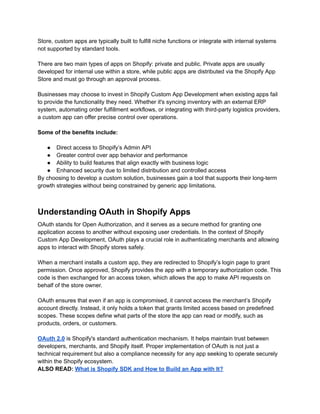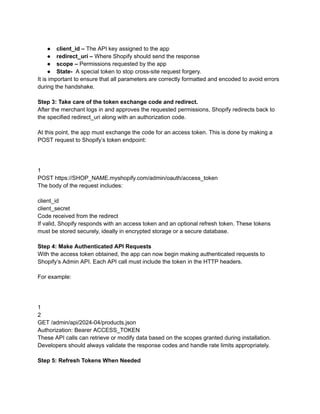Shopify Custom App Development_ How to Implement OAuth and Protect Customer Data.pdf
- 1. Shopify Custom App Development: How to Implement OAuth and Protect Customer Data Introduction In today’s highly customized e-commerce environment, relying solely on off-the-shelf tools often limits a store’s growth potential. That’s why many businesses turn to Shopify custom app development to build tailored solutions that align precisely with their workflows, systems, and customer experiences. But with that customization comes the need for security, particularly when handling sensitive store and customer data. One of the foundational elements of secure Shopify app architecture is OAuth, the industry-standard protocol for authentication and authorization. This guide explores how OAuth works in Shopify custom apps, why it’s critical, and what best practices you need to follow to protect data and build merchant trust. What is Shopify Custom App Development? Shopify Custom App Development refers to the creation of tailor-made applications designed specifically for a single merchant or business. Unlike public apps found in the Shopify App
- 2. Store, custom apps are typically built to fulfill niche functions or integrate with internal systems not supported by standard tools. There are two main types of apps on Shopify: private and public. Private apps are usually developed for internal use within a store, while public apps are distributed via the Shopify App Store and must go through an approval process. Businesses may choose to invest in Shopify Custom App Development when existing apps fail to provide the functionality they need. Whether it's syncing inventory with an external ERP system, automating order fulfillment workflows, or integrating with third-party logistics providers, a custom app can offer precise control over operations. Some of the benefits include: ● Direct access to Shopify’s Admin API ● Greater control over app behavior and performance ● Ability to build features that align exactly with business logic ● Enhanced security due to limited distribution and controlled access By choosing to develop a custom solution, businesses gain a tool that supports their long-term growth strategies without being constrained by generic app limitations. Understanding OAuth in Shopify Apps OAuth stands for Open Authorization, and it serves as a secure method for granting one application access to another without exposing user credentials. In the context of Shopify Custom App Development, OAuth plays a crucial role in authenticating merchants and allowing apps to interact with Shopify stores safely. When a merchant installs a custom app, they are redirected to Shopify’s login page to grant permission. Once approved, Shopify provides the app with a temporary authorization code. This code is then exchanged for an access token, which allows the app to make API requests on behalf of the store owner. OAuth ensures that even if an app is compromised, it cannot access the merchant’s Shopify account directly. Instead, it only holds a token that grants limited access based on predefined scopes. These scopes define what parts of the store the app can read or modify, such as products, orders, or customers. OAuth 2.0 is Shopify's standard authentication mechanism. It helps maintain trust between developers, merchants, and Shopify itself. Proper implementation of OAuth is not just a technical requirement but also a compliance necessity for any app seeking to operate securely within the Shopify ecosystem. ALSO READ: What is Shopify SDK and How to Build an App with It?
- 3. Step-by-Step Guide to Implement OAuth in Shopify Custom Apps Step 1: Register Your App in Shopify Partners Dashboard Before beginning development, an app must be registered in the Shopify Partners Dashboard. This is where developers create new apps and configure settings such as redirect URLs and API credentials. Once logged into the dashboard, navigate to the “Apps” section and select “Create a new app.” The system will generate an API key and secret, which are essential for initiating the OAuth flow. These keys should be kept confidential and never exposed publicly. During registration, developers are required to specify the redirect URI. This is the URL where Shopify will send the authorization code after the merchant approves the app. Multiple redirect URIs can be added for different environments (development, staging, production). Step 2: Initiate OAuth Authorization Request To start the authentication process, the app must redirect the merchant to Shopify’s OAuth endpoint. The URL includes parameters such as client_id, redirect_uri, and scope. For example: 1 https://SHOP_NAME.myshopify.com/admin/oauth/authorize?client_id=API_KEY&redirect_uri=R EDIRECT_URI&scope=SCOPE_LIST&state=UNIQUE_STATE_TOKEN Each parameter plays a role:
- 4. ● client_id – The API key assigned to the app ● redirect_uri – Where Shopify should send the response ● scope – Permissions requested by the app ● State- A special token to stop cross-site request forgery. It is important to ensure that all parameters are correctly formatted and encoded to avoid errors during the handshake. Step 3: Take care of the token exchange code and redirect. After the merchant logs in and approves the requested permissions, Shopify redirects back to the specified redirect_uri along with an authorization code. At this point, the app must exchange the code for an access token. This is done by making a POST request to Shopify’s token endpoint: 1 POST https://SHOP_NAME.myshopify.com/admin/oauth/access_token The body of the request includes: client_id client_secret Code received from the redirect If valid, Shopify responds with an access token and an optional refresh token. These tokens must be stored securely, ideally in encrypted storage or a secure database. Step 4: Make Authenticated API Requests With the access token obtained, the app can now begin making authenticated requests to Shopify’s Admin API. Each API call must include the token in the HTTP headers. For example: 1 2 GET /admin/api/2024-04/products.json Authorization: Bearer ACCESS_TOKEN These API calls can retrieve or modify data based on the scopes granted during installation. Developers should always validate the response codes and handle rate limits appropriately. Step 5: Refresh Tokens When Needed
- 5. Shopify's access tokens have a finite lifetime. To continue accessing the store beyond expiration, a refresh token must be used. Developers should implement logic to detect expired tokens and automatically initiate the refresh process using the refresh token. This ensures continuous access without requiring the merchant to re-authorize the app manually. Proper handling of the token lifecycle is essential for maintaining uninterrupted service and avoiding disruptions in app functionality. Why Protecting Customer Data Matters In the world of Shopify Custom App Development, handling customer data responsibly is not optional—it is a core obligation. Shopify stores often contain large amounts of personal and financial information, including names, addresses, email addresses, and purchase histories. Failing to protect this data can lead to serious consequences: ● Loss of customer trust ● Legal penalties under data protection laws (e.g., GDPR) ● Damage to brand reputation ● Financial losses due to breaches Secure authentication via OAuth is just one layer of defense. Equally important is how data is stored, transmitted, and accessed once inside the app environment. Even small oversights can expose sensitive information to unauthorized parties. By prioritizing data protection from the outset, businesses not only comply with regulations but also demonstrate a commitment to ethical and responsible software development.
- 6. Best Practices for Securing Customer Data in Shopify Custom Apps Use HTTPS Everywhere: The app and Shopify must communicate exclusively via HTTPS. This prevents man-in-the-middle attacks and ensures that data remains encrypted during transmission. Developers should enforce HTTPS at both the server and client levels. Store Tokens Securely: Access and refresh tokens should never be stored in plaintext. Instead, they should be encrypted and saved in secure databases or vaults. Avoid logging tokens or exposing them in error messages. Minimize Data Collection: Only collect and retain the data necessary for the app to function. Reducing the amount of stored information lowers the risk associated with potential breaches. Implement Role-Based Access: Within the app, restrict access to certain features based on user roles. For example, support staff might only need read access, while administrators require full permissions. Audit Logs Regularly: Maintaining detailed logs of API activity helps detect unusual behavior early. These logs should be reviewed periodically to identify and respond to suspicious patterns. Encrypt Sensitive Data at Rest: Even if data is stored internally, it should be encrypted. If the database is accessed without authorization, this provides an additional degree of security.
- 7. Follow Shopify’s API Guidelines: Shopify provides clear documentation on how apps should behave. Adhering to these guidelines ensures compatibility, improves security, and maintains compliance with Shopify’s policies. These best practices should be integrated into every phase of the app development lifecycle, from planning to deployment and maintenance. Choosing the Right Developer for Shopify Custom App Development Selecting the right developer or agency for Shopify Custom App Development is critical. The complexity of implementing OAuth and securing customer data requires expertise in both Shopify’s architecture and modern security standards. Businesses should look for developers who: ● Demonstrate a deep understanding of Shopify’s API structure ● Have experience building secure integrations ● Can explain how OAuth and token management work ● Are transparent about data handling practices A strong developer will not only deliver functional code but also ensure that the app meets Shopify’s security expectations and industry standards. Asking for references, reviewing past projects, and conducting technical interviews can help identify a capable partner. Investing time in vetting developers leads to better outcomes and reduces long-term risks. Conclusion Securing customer data isn’t just a technical requirement—it’s a cornerstone of responsible Shopify custom app development. Implementing OAuth correctly allows your app to interact with store data securely, minimizes exposure, and reinforces trust between your app and the merchant. From token handling to compliance-driven development practices, every detail matters. Whether you’re a merchant planning a custom integration or a developer bringing that vision to life, prioritizing security from the start ensures your app is both powerful and trustworthy in the long run. If you're looking to build a secure, high-performance solution tailored to your store's unique needs, CartCoders offers specialized Shopify custom app development services backed by deep technical expertise. Whether you’re streamlining operations, integrating third-party
- 8. systems, or creating functionality not available in the Shopify App Store, our team delivers scalable, security-focused apps aligned with Shopify’s best practices. Have questions or a project in mind? You can easily get in touch with our Shopify app experts to explore how we can support your business.








